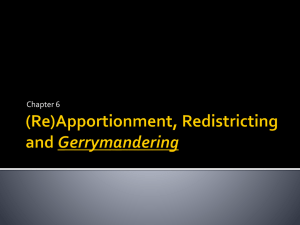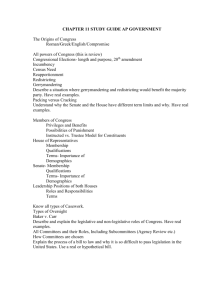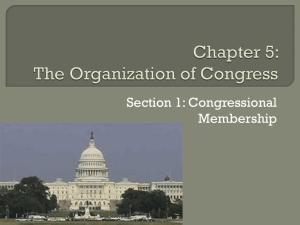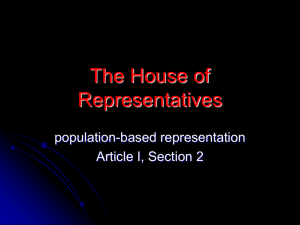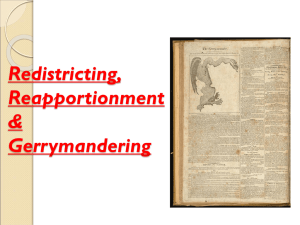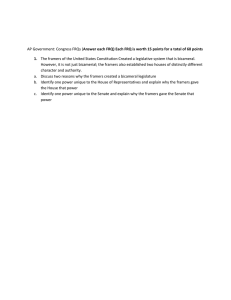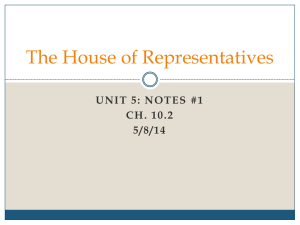Notes
advertisement
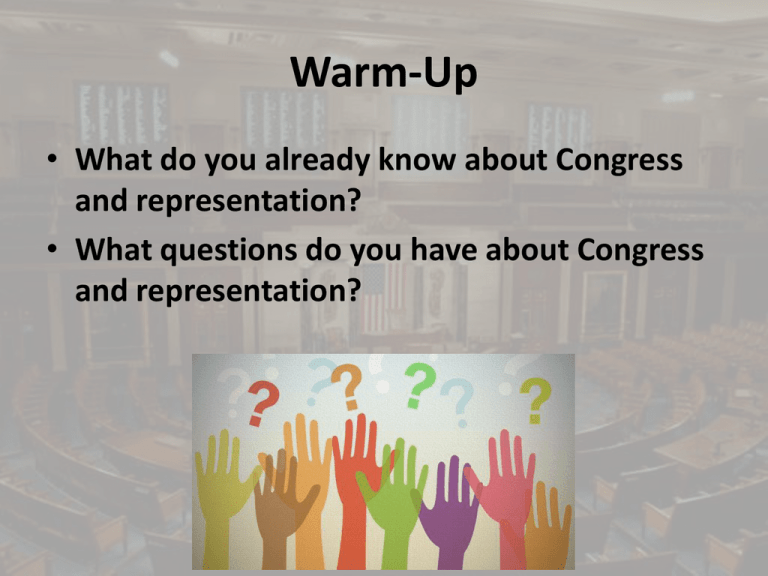
Warm-Up • What do you already know about Congress and representation? • What questions do you have about Congress and representation? The House of Representatives Essential Question: Does the constitutional model of representation provide effective representation today? Article I, Section 1 • “All legislative powers herein granted shall be vested in a Congress…” • Article II, Section 2 = “The executive power shall be vested in a President…” • The Constitution grants Congress with the most power, therefore powers are specifically listed out and Congress is divided into two chambers Article I, Section 2 • The House of Representatives – – – – – – 2 year terms Directly elected by the people 25+ years old A citizen for 7+ years Resident of the state they will be a rep for 1 representative for every 30,000 residents in a state (all states get at least 1 representative) – Reps choose the Speaker of the House – The House has the power to impeach (Senate has the power of removal from office) Closest to the People • Short terms cause Representatives to be attentive to their constituents • Always in “re-election mode” • Hold an office in their district in their state and report to Capitol Hill • Responsible to advocate for the constituents in their district in federal matters • Legislative district – territorial areas partitioned on a map designating areas of representation by a legislative body • Apportionment – the determination of the # of members in the House according to the proportion of the population of each state to the total population of the U.S. • Gerrymander – Drawing a district with boundaries that favor one more groups of voters and/or some candidates over others – Partisan gerrymandering: favors one political party over others – Racial gerrymandering: favors one racial group over others Constitution Convention • Established a system of apportionment where states are divided into separate legislative districts ; each district must have roughly the same # of people • Art. I, Sec. 2 requires a Census to be taken every 10 years to account for the total number of people living in a state – 1 representative “awarded” for every 30,000 people • Reapportionment takes place after the Census to adjust the House to demographic changes Early Politics • Governor Elbridge Gerry had Massachusetts’ congressional districts redrawn to strengthen his political party in 1812 • Elkanah Tisdale, a political cartoonist, created a cartoon of these districts that resembled a salamander 19th Century Developments • American growth and expansion required redistricting after each Census to keep up with the growing population and demographic shifts Caps on the Total Number of Seats • 1911 – Congress caps that number of seats in the House at 433 • Arguments ensue after the 1920 Census on the appropriate formula for reapportionment • 1929 – Congress finally settles on a cap of 435 seats for the House Civil Rights Movement • Baker v. Carr (1962) – 14th Amendment’s equal protection clause requires districts to be equal in population so that one person’s vote would not weigh more than another person’s vote – “one person, one vote” • Voting Rights Act (1965) – states with a history of discriminatory voting practices had to get preclearance from the federal government before redrawing their district lines • Shaw v. Reno (1993) and Miller v. Johnson (1999) confirmed that racial gerrymandering was unconstitutional, however partisan gerrymandering is not Current Movement to Standing Committees • States such as Washington, California, and Arizona have created standing committees that include citizens for the purpose of redistricting • CA Prop 11 (2008) authorized the creation of the California Citizens Redistricting Commission • CA Prop 20 (2010) empowered the California Citizens Redistricting Commission to redraw the boundaries of CA’s congressional districts How it Works You try! R R R D D R D D R R D D R R R R D D D D R R R D Create 5 congressional districts for the state to favor the Republican Party One person, one vote dictates that there must be at least 4 and no more than 5 counties in each congressional district A district’s geographical span must be contiguous You try! R R R D D R D D R R D D R R R R D D D D R R R D Create 5 congressional districts for the state to favor the Democratic Party One person, one vote dictates that there must be at least 4 and no more than 5 counties in each congressional district A district’s geographical span must be contiguous Reading • The Great Gerrymander of 2012 • Now That’s What I Call Gerrymandering!
